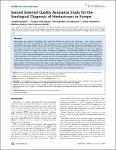Second External Quality Assurance Study for the Serological Diagnosis of Hantaviruses in Europe
Escadafal, Camille
Avšič-Županc, Tatjana
Vapalahti, Olli
Niklasson, Bo
Teichmann, Anette
Niedrig, Matthias
Mantke, Oliver Donoso
Hantaviruses are endemic throughout the world and hosted by rodents and insectivores. Two human zoonoses, hemorrhagic fever with renal syndrome (HFRS) and hantavirus pulmonary syndrome (HPS), are caused by hantaviruses and case fatality rates have reached 12% for HFRS and 50% for HPS in some outbreaks. Symptomatic hantavirus infections in Europe are summarised as HFRS mainly due to Puumala, Dobrava-Belgrade and Saaremaa virus. While HFRS has an overall low incidence in Europe, the number of cases varies from 100 per year in all Eastern and Southern Europe up to 1,000 per year only in Finland. To assess the quality of hantavirus diagnostics, the European Network for the Diagnostics of ‘‘Imported’’ Viral Diseases (ENIVD) organised a first external quality assurance (EQA) in 2002. The purpose of this second EQA study is to collect updated information on the efficiency and accurateness of hantavirus serological methods applied by expert laboratories. A serum panel of 14 samples was sent to 28 participants in Europe of which 27 sent results. Performance in hantavirus diagnosis varied not only on the method used but also on the laboratories and the subclass of antibodies tested. Commercial and in-house assays performed almost equally. Enzyme immunoassays were mainly used but did not show the best performances while immunoblot assays were the less employed and showed overall better performances. IgM antibodies were not detected in 61% of the positive IgM samples and IgM detection was not performed by 7% of the laboratories indicating a risk of overlooking acute infections in patients. Uneven performances using the same method is indicating that there is still a need for improving testing conditions and standardizing protocols.
Dateien zu dieser Publikation
Keine Lizenzangabe

